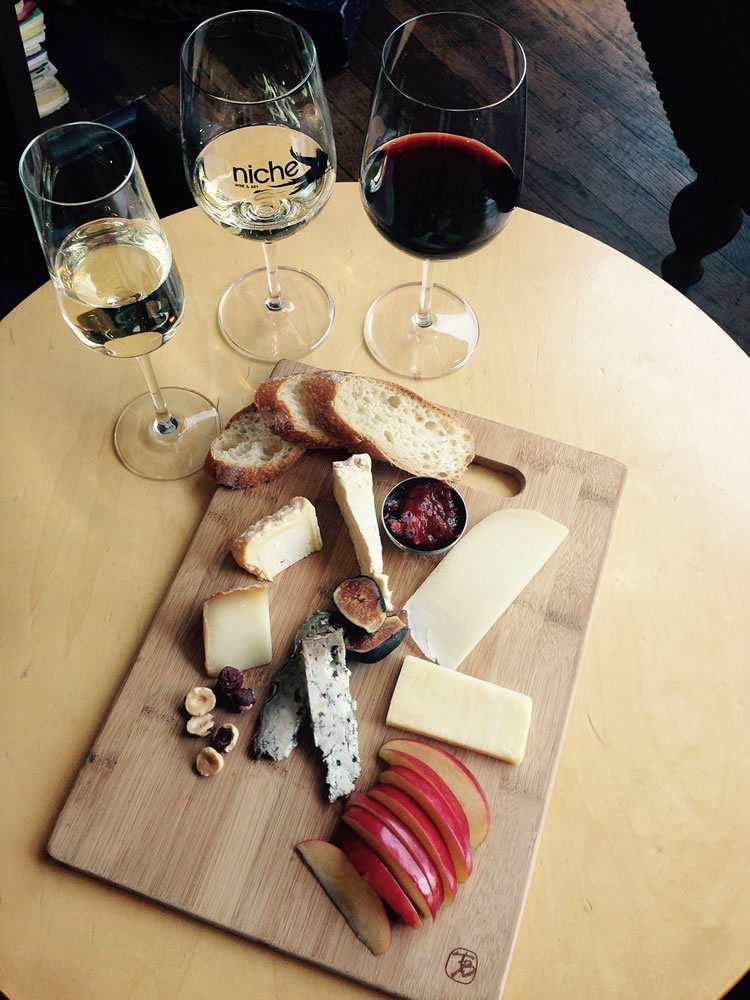Gamey, terroir and buttery are all terms used to describe wine that also can apply to the wonderful world of cheese. From soft to hard, mild to sharp and sweet to salty, there’s a perfect cheese — or three — for every wine and every occasion that calls for a satiating slice of protein.
I spoke with Leah Jackson, owner of Niche Wine & Art Bar in downtown Vancouver, and Greg Bee, a wine steward at Niche, for the lowdown on curds for the everyday.
Jackson went straight for sparkling wine with fatty cheeses and, yes, bubbles should come out and play throughout the year, particularly during warm summer weather. She stressed that a sparkling with a dry — or brut — finish is the ideal style to pair with the texture of double crème cheeses such as brie or Camembert or triple crème such as Brillat-Savarin or blue Castello. “Double” and “triple” refer to the butterfat content — at least 60 and 75 percent, respectively — but these cheeses are actually less fat rich than cheddar, and their melt-in-your-mouth quality is a decadent treat with the medium to high acidity found in Spanish cavas and French crémants.
For a twist on another traditional cheese pairing (port and blue cheese), Jackson suggests sauternes, with their sweetness derived from grape-growing practices instead of wine-making methods. The high-acid content balanced with honey characteristics make an excellent accompaniment to more pungent blue cheeses, but she added that sauternes also do well with the above-noted creamy cheeses, so two completely different wine styles with a couple of the same cheeses allows for efficient experimentation.
Bee explained wine and cheese pairing as similar to wine and meat pairings. The tannins in wine adhere to protein instead of the wine drinker’s mouth much as a big steak brings out the fruitiness of an Italian barbaresco and tones down some of the more earthy characteristics. So think Parmigiano-Reggiano, cheddar and Gorgonzola with full-bodied reds. Pinot gris, riesling and gewürztraminer, which are known to tame the spiciness of Thai food, are wonderful with the peppery finish of a Spanish blue cheese or a pepper jack or even jalapeño-infused cheeses. Cheeses with some earthiness or nuttiness such as aged Gouda or goat or smoked cheddar complement the forest floor notes of elegant pinot noirs.
Simple foods to accompany a well-dressed cheese platter could include honey to drizzle over pecorino, stewed fruit, jams, figs, a variety of nuts from raw to toasted and, Jackson reminded, apples are a go-to, along with pears that will be coming along soon.
“When I first started (experimenting with cheeses), I used a lot of bread, and now we’re sitting here with a picked-over cheese plate, and neither one of us has touched the bread,” Jackson said.
For some extra guidance, the Vancouver Cheese Board meets at Niche from 5 to 7 p.m. on the last Tuesday of every month. Typically four wines are paired with four cheeses, and there’s an informal discussion about what works well, what doesn’t and why. Future tastings also will showcase sake, ciders and beers.
Jackson and Bee agreed that creating the perfect cheese platter should be fun and that any wine steward or cheese monger should be able to help home in on great, affordable options.
Just as with wine education, ask questions but don’t focus too much on rules in lieu of your personal tastes.
Viki Eierdam is a Clark County native who lives in Battle Ground. She is certified by the Wine & Spirit Education Trust. Read the Corks & Forks blog at blogs.columbian.com/corks-and-forks



